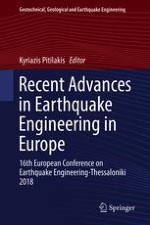This book is a collection of invited lectures including the 5th Nicholas Ambraseys distinguished lecture, four keynote lectures and twenty-two thematic lectures presented at the 16th European Conference on Earthquake Engineering, held in Thessaloniki, Greece, in June 2018. The lectures are put into chapters written by the most prominent internationally recognized academics, scientists, engineers and researchers in Europe. They address a comprehensive collection of state-of-the-art and cutting-edge topics in earthquake engineering, engineering seismology and seismic risk assessment and management.
The book is of interest to civil engineers, engineering seismologists, seismic risk managers, policymakers and consulting companies covering a wide spectrum of fields from geotechnical and structural earthquake engineering, to engineering seismology and seismic risk assessment and management. Scientists, professional engineers, researchers, civil protection policymakers and students interested in the seismic design of civil engineering structures and infrastructures, hazard and risk assessment, seismic mitigation policies and strategies, will find in this book not only the most recent advances in the state-of-the-art, but also new ideas on future earthquake engineering and resilient design of structures.
Chapter 1 of this book is available open access under a CC BY 4.0 license.
